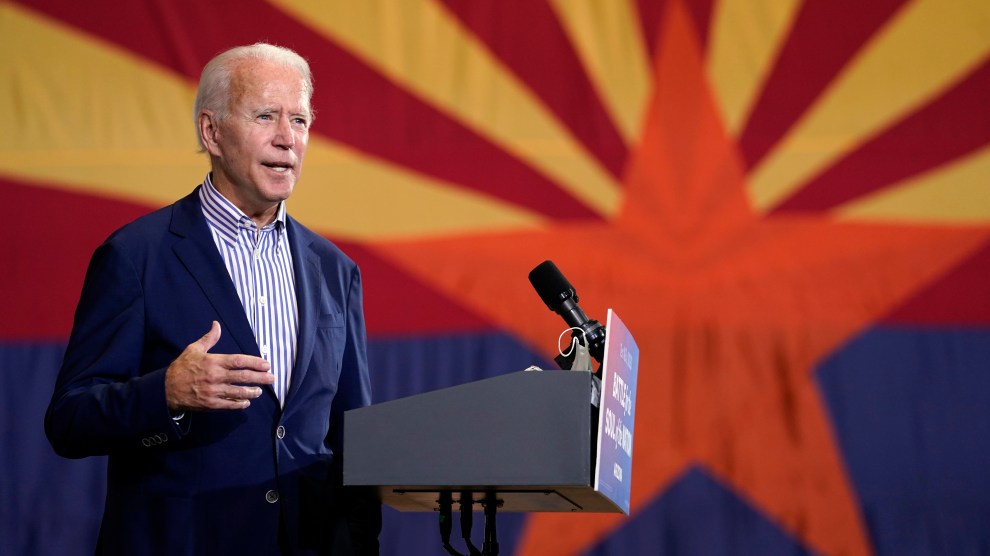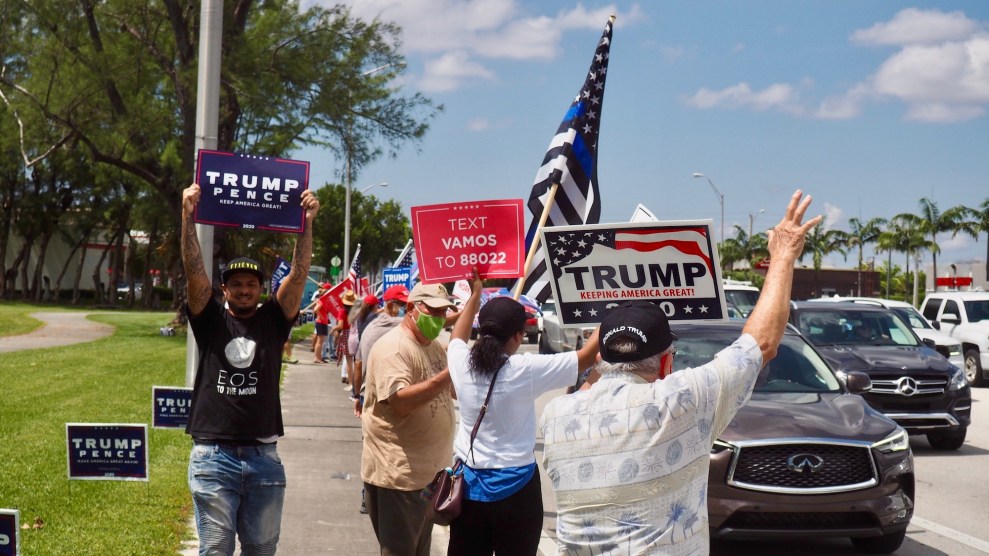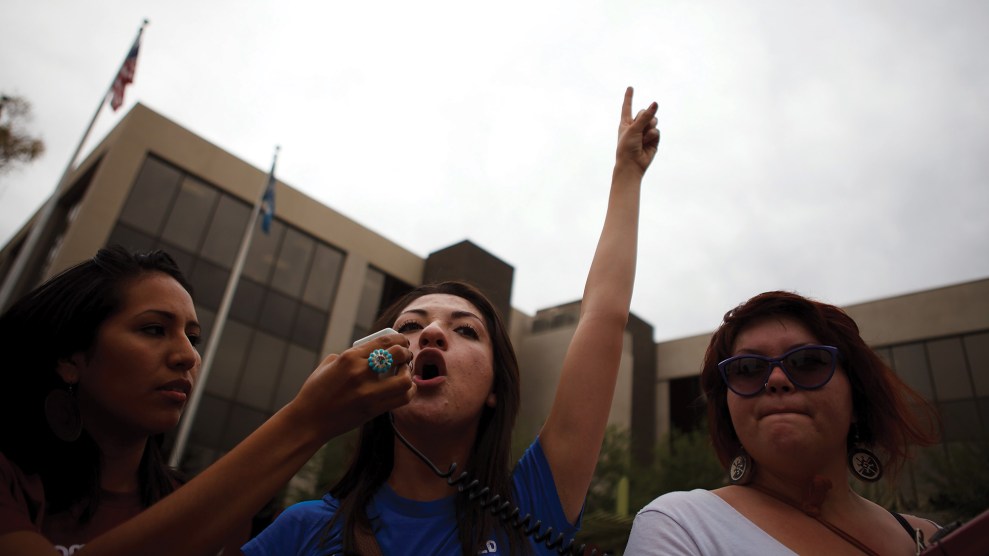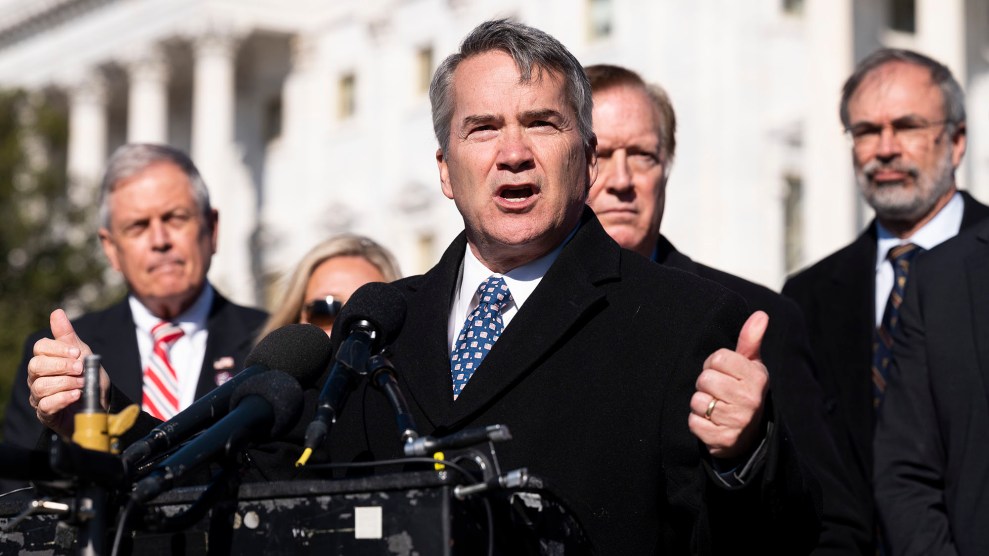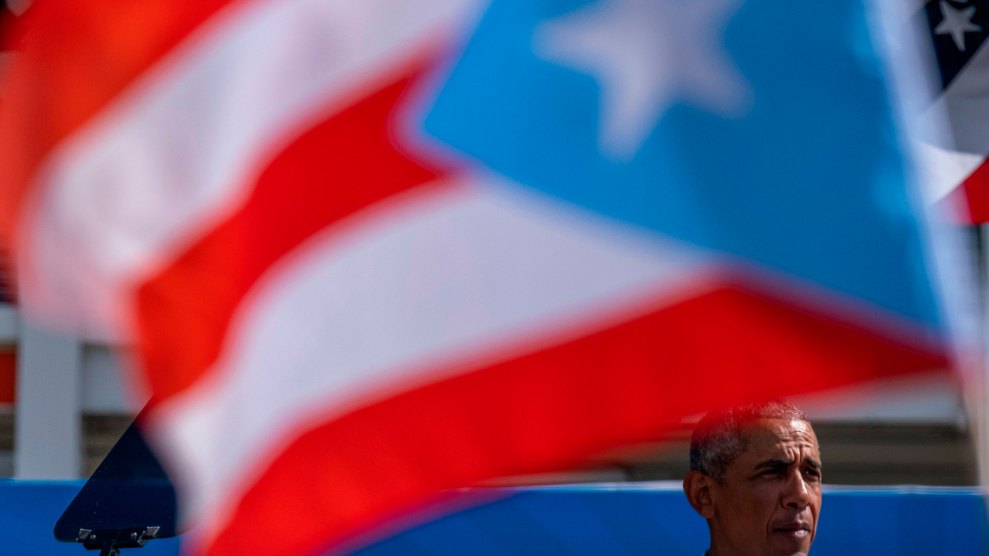
The Puerto Rican flag waves as former President Barack Obama speaks at a Biden–Harris drive-in rally in Orlando, Florida, in October. Ricardo Aruengo/AFP/Getty Images
Long before the 2020 election, Latino leaders saw the true power of a unified voting bloc. In 1971, Latino politicians, led by Herman Badillo, a Puerto Rican congressman from New York, and Edward Roybal, a Mexican American congressman from Los Angeles, sought to create a broad coalition of Spanish-speaking people from across the country. The goal was political power, and they operated under a vision of cultural unity guided by shared policy interests.
As political historian Benjamin Francis-Fallon writes in his 2019 book The Rise of the Latino Vote: A History, more than a thousand people, mostly of Mexican and Puerto Rican descent, ranging from leftists to farmworker activists to members of Congress, converged on the Hospitality House Motor Inn in Arlington, Virginia, just south of Washington, DC, for the Unidos conference.
“Though this ostensible movement for Spanish-speaking political independence faltered, many of the personal relationships, policy visions, and power-sharing ideas of the Unidos conference would help transform the Democratic Party in 1972,” Francis-Fallon writes. “As the Democratic congressmen advanced the party’s multicultural reconfiguration, they still worked to infuse its official diversity with a strongly inclusive economic agenda that resonated with both their urban, New Deal roots, and the ambitions of a growing Latino bureaucratic class.”
Thus was born “the Latino vote”—not a monolith but a coalition. Today it’s a vexing, double-edged category, the subject of much dispute. Going into the 2020 election, one operating assumption was that Latinos, poised to become the nation’s second-largest voting group, would turn out as a bloc the same way Black voters have for Democrats. Undergirding this analysis was Badillo and Roybal’s image of the Latino vote as a single unit, only without their understanding of the nuances and contingencies at the heart of that political group.
In many ways, those nuances and contingencies are the big stories of the election. Latino activists, guided by years of grassroots mobilizing, catapulted Biden to a win in Arizona while a significant number of Latino voters in South Florida and parts of Texas pulled the lever for Donald Trump. The reminder to political pundits that Latino voters are not a monolith became a sort of refrain in the election’s aftermath.
Recently I spoke with Francis-Fallon, an associate professor at Western Carolina University, about the many misunderstandings of the Latino vote. We talked about “the monolith conversation” of the present day; its origins in both the hard political spadework performed by Latino themselves and the subsequent punditry about Latinos as the “sleeping giant,” always on the cusp of realizing their destiny; why Republicans at one point saw Latino voters as the “good minority” for political gain; and what we can learn from the early efforts at unity among Latino voters.
What drew you to look at the history of the Latino Vote?
Long ago, I was looking at how Salvadorans in Washington, DC, tried to figure out local politics in a city where they were becoming the numerically dominant Latino population. I began to see that underneath the broad canopy of a whole bunch of different terms that were used at the time—Spanish surnames, Spanish speaking, Spanish origin, other pan-ethnic terms like that—Latinos were at once seeking power but also trying to define their relationships to one another. In the course of doing that local research, a name that kept popping up was Richard Nixon, and I began to realize that Republicans were at the forefront of trying to consolidate and to some degree manipulate this notion that there was a national constituency being born out of all of these disparate populations.
Why were Republicans at the forefront of consolidating this constituency?
Some of it is just down to timing. Republicans happened to be in the White House at a time when activism in Mexican America and among Puerto Ricans was reaching a crescendo and very strong challenges to traditional politics and Democratic Party politics were shaking the establishments in those communities. Republicans saw an opportunity to profit from that unrest, and to profit from unrest they associated with African Americans, to profit from urban unrest generally by appealing to what they called Spanish-speaking Americans, as a sort of a “good minority.” Republicans sometimes called them one of the groups of silent minorities.
Republicans were in the White House and had the power of patronage at their disposal and were willing to use it to see if they might pick off enough parts of this community that they could substantially disorganize the Democratic coalition, even more than it was being disorganized at the time, and then weld those, the more conservative, the more middle-class, the more upwardly mobile elements of Latino America, especially Mexican Americans, to the GOP coalition.
Did it work? To what extent were they successful?
Here it makes the most sense to appreciate that while Republicans were influential, Latinos were never in this period majority for Republicans. The crucial drivers of this project of making a Latino vote were Democrats. But it was surely a project taking place in two parties. Latino Democrats were the organizational innovators in the process. The most influential people that I found, who acted in this way to create alliances among Mexican Americans and Puerto Ricans, especially, were in Congress. And that was Edward Roybal, who was the Los Angeles congressman, elected in 1962, and then Herman Badillo, who was a New York Puerto Rican, elected to the House in 1970.
When Badillo got to Washington, he met Roybal, and they began this friendship and alliance that was maybe not close but was valuable in transmitting to the Democratic Party the idea that there was now what they began to call either a Spanish-speaking or a Latino constituency that was united and that needed to be taken as seriously as Democrats took African Americans. That resulted in a host of structural innovations within the party—the creation of a Latino Caucus within the Democratic Party, and then the ultimately the creation of things like the Congressional Hispanic Caucus and NALEO, institutions that established permanently that idea that there was the single constituency—however diverse, it might be.
Why was there an alliance between Mexican Americans and Puerto Ricans?
The simplest part of the answer is strength in numbers. In the previous decade, Mexican Americans were strongly associated with the Southwest, and for good reason. African Americans were associated with the South, but they were also associated with the urban North and the urban West because of their migration. While Mexican Americans migrated to the industrial Midwest—places like Chicago, Detroit—in those areas, there was still a sense that Mexican Americans were kind of regional and not a national priority. An alliance with Puerto Ricans swept the map by being able to claim that these Spanish-speaking Americans were crucial in all of these places, from coast to coast, and crucial in two of the biggest Electoral College states as well.
So we’ve got Roybal from California, and then Badillo from New York, and they’re really making the case that you could win the presidency if you just took us seriously in this place, in this place, and in Texas—that together, with everything else, you win. The idea was that, together, they would hold the balance of power in the presidential election. With that recognition of their collective strength, they could compel the government to recognize them as a civil rights and policy constituency.
Latinos had felt separately passed over in many ways by the War on Poverty, had felt neglected in terms of public employment in the cities they lived in, but also in the federal government. I don’t know if people grasp how important public employment is as an engine of social mobility and as a signifier of political inclusion. But this is very much on the minds of Latino activists—these very quantifiable ways of showing that the government cared about you, like seeing yourselves in the civil service, seeing grants flowing to your communities. Divided as regional peoples, there was no way the numbers could be compelling to the federal government.
It’s the prospect of numbers. It’s the sense that the Democratic Party was not unjustly preoccupied by Black concerns but used preoccupations with Black concerns as a shield to say, “We’re doing things for minorities, and that means something to you, too.” There was sort of a longstanding quest among Democrats to mobilize Latinos as a bloc when it came to elections, but then to pretend that they were much more like any other ethnic voters afterward, that they didn’t necessarily deserve targeted public policies.
At various points from the ’60s to at least 1980, Democrats would run these Latino campaigns. And then afterward, people say, “Okay, well, what about the policies to target our specific community? You targeted us at election time.” And then there would be all this, “Well, you know, we don’t want to do too much for a special interest, and no one group has a claim,” and this kind of stuff—which is nonsense. Democrats didn’t do that to African Americans for the most part during the period, and Latino leaders saw that and recognized that and said: “Come on. That’s garbage. They made you care about them, and we want you to care about us.” There’s some quote from the early ’60s when Mexican American leaders are talking about Pat Brown in California. And they were like, you know, Pat Brown used to claim that he didn’t see color, but the NAACP made him see color. And Latino leaders wanted that similar ability to compel white leaders’ attention.
What were the issues that brought Mexican American leaders together with Puerto Ricans? Were there common issues that they focused on?
Initially, it seemed as if there weren’t such common issues. From the mid-1960s, I talk about this in the book, the Johnson administration tries to placate Mexican American leaders by holding an event to enumerate their policy concerns and then explain all the ways that the Johnson government is addressing them. And somebody says, “Well, you know, we should invite Puerto Ricans as well.” This is maybe 1966 or so.
White folks in the Johnson government go around and start asking questions. The Mexican American leaders say they don’t want the Puerto Ricans to be at their conference. They don’t want to share the spotlight. And the conclusion of the Johnson administration was that part of it was just a desire for unique attention. Part of it was also a sense that the issues are varied.
So the Johnson administration, for example, says that most Mexican Americans care about the border and Puerto Ricans don’t. There was still some sense then that policymakers identified Mexican Americans as a rural people—I think in part because of the influence of the farmworker movement in constructing an image of the Mexican American as part of the agricultural workforce. Puerto Ricans, while definitely part of the agricultural workforce, too, policymakers saw them as Northern people, people who were city dwellers and had city issues.
What’s important about this period, from between 1966 to, say, 1972, Mexican Americans and Puerto Ricans have to discover their issues. They have to meet and talk about, “What actually do we have in common?” What they come up with is not any question about immigration because it’s not a common issue. They look for common issues, and they find things like affirmative action, equal access to the War on Poverty, public employment, bilingual education, bicultural education. But they unite about other things, too, such as opposition to the Vietnam War. This is among liberal Mexican Americans and Puerto Ricans.
They have a great conclave in Washington, DC, in 1971 where more than 1,000 Mexican Americans and Puerto Ricans come from across the country to try to hammer out a policy agenda that unites the people. So immigration becomes a bigger issue by the end of the 1970s. But initially, it’s off the radar. What these conversations do is they outline policies that are thought of as common, but they also just establish frameworks in which new policies can be then identified as Hispanic or Latino policies. In some sense, the stamp of these organizations that are created on particular policies is a way of branding them as ethnically relevant. So national health insurance becomes a Latino issue for this, this, and this reason, the full-employment act becomes a Latino issue because our families need this, that, and the other.
In other words, the fight is to make mainstream policies seem reflective of ethnic values as well. So it’s not just particularism. It’s a way of making Latino political identity potent on a range of issues that are meaningful, some of which are not your standard identity politics—the really hardcore, progressive, democratic economic policy platforms that Latino leaders are trying to tune and pitch in ways that reflect an ethnic validity, authenticity, and relevance.
What were some of those conversations like early on?
There’s a few different ways in which these conversations take place. Some are like the conference I mentioned in 1971, which is called the Unidos conference. That’s this coming together. Roybal and Badillo invited like a couple hundred people, mostly people they knew and trusted to get together to hammer out a policy platform, and then everybody and their grandmother showed up from mainstream groups like the ones the congressmen wanted, but also radicals, people like José Angel Gutiérrez of La Raza Unidad Party, and Reies Tijerina, the land-grant activist. The Young Lords showed up. Everybody knew that this was important, and they didn’t want anybody else speaking for them.
So there’s that kind of grassroots moment. They’re meeting in a smoky hotel in these conference rooms, and they’re talking about: “Well, okay. Do we focus on issues that are the same for all of us? Or do we recognize that what we’re doing is kind of a coalitional thing? We’re building a coalition, in which we look after each other’s issues. So you know, if there are leftists here, and they want Puerto Rican independence, is this an issue for all of us, even though we don’t have any connection to Puerto Rico? Similarly, for those of us who are concerned about migration in the US–Mexico border and the INS and deportation and things like that, is that an issue for Puerto Ricans?”
So those kinds of workings-out are happening. What kind of coalition is it? Is it around common issues? Or is it one that underscores that the groups are distinctive and need to aid each other. Different, moderate mainstream folks don’t really want to talk about Puerto Rican independence. The moderate perspective is to look for commonality because that gets you into a safe space.
There are other venues in which this is discussed. There’s the Democratic National Convention. That’s a moment in which new Latino positions are articulated. But it’s done in dialogue with the campaigns. It’s not necessarily an autonomous activity, because Latino policies, Latino stances are being made by delegates of the presidential candidate. So the Latino voice is articulated to validate what the policy platforms of the candidates are. That happens in 1972. The McGovern campaign has a whole bunch of working-class ethnic issues that are identified as Latino issues. And as liberalism changes, if you look to 1980, Jimmy Carter, a lot of that working-class agenda recedes a bit, and there’s more kind of social issues being identified as Latino issues. This is really important in a lot of ways. There’s more attention to gay rights and equality as being Latino issues. But there’s also a certain amount of retreat from some of the economic program of more liberal meetings of Latinos.
This coalition-building seems ideal. How does it feed into the myth of what we’re seeing now as Latinos being treated as a monolith?
It’s a fantastic question. The people that I’m talking about, they never perceived themselves to be a monolith. That was externally imposed. What they did see was that they were attempting to forge unity and togetherness and a sense of what I think political scientists called linked fate. At times, that led them to obscure their differences in the way they presented themselves to the public, and so that to a degree imparted a sense of sameness.
It’s also important to recognize the political world in which the Latino vote was created is not the one of the present day, either. It was a much simpler demographic mix that the makers of the Latino vote sought to coordinate. In the ’60s, in the ’70s, they talked about Mexican Americans, Puerto Ricans, and Cubans. They didn’t worry about Salvadorans and Venezuelans, Colombians. Everybody else was too small to matter.
So that was a problem for the future. For a lot of this time, Cubans were just beginning to wade into domestic politics. They were just beginning to naturalize in big numbers. So the idea among the liberal Democrats who were most responsible for the Latino vote concept was: We’re basically liberal in California, and they’re basically liberal in New York, and well, it was a fairly decent basis for unity, The Tejanos, they can probably come along with us, too. It wasn’t so far fetched. But Cubans’ involvement complicated things for Democrats, and then certainly for Republicans.
What was it that drew Latino voters to the Republican Party versus the Democrats?
An array of issues. These range from a sense that Democrats catered exclusively to Black concerns. Some had been Democrats and had broken with the party over Vietnam and, along Cold War lines, saw the Republican Party as a more patriotic example for them. Some were conservative Catholics and took the Democratic Party’s leftward movement in the ’60s and ’70s as favoring disorder and concerning them greatly. Some thought that they were doing something for their people by making them more integrated into the other political party, that they were creating competition for their people’s votes. That’s what they told us that they told themselves.
Cubans hated Kennedy after the Bay of Pigs, and there was nobody in the Democratic Party who could compete with Ronald Reagan for anti-communist bona fides, at least as they saw it. There were Cubans who came into the Republican Party not just in Florida but in California as well. And anti-communism is obviously job one for them.
What role do you think immigration played historically in shaping the makeup of the Latino vote and carving out the differences within the Latino vote?
It’s a crucial question that’s still very much unfolding, right? Because I think the Immigration Act of 1965 does two things. It facilitates family migration. But it also hardens the legal access routes for people from the hemisphere, so it at once opens doors and then creates new boundaries that facilitate the rising numbers of immigrants who end up being undocumented because there’s not a legal path for them.
The shortcomings in that legislation fueled the transformation of Latino politics into a process that has to deal with the question of undocumented migration. That scrambles things a little bit. It forces groups who don’t have migration issues in the same way, Puerto Ricans especially, to have to ask questions about how invested they are in the migration issues of others and whether or not they they can somehow escape the stigma of being associated with undocumented status, which is obviously leveled most at Mexican people. But also, if you’re a part of the same group, then it’s leveled at other Latinos as well—that stigma.
It creates challenges for naming. Naming is always an issue when you’re trying to create an umbrella term for diverse people who like or don’t like one of the terms. It creates new issues for how to balance patronage and attention. And it creates questions of succession because as new immigrants move into areas, they often move into Latino areas and they become more numerous, oftentimes than the groups that had been there, but maybe the congressman is still Puerto Rican. Now it’s a Dominican area. So there are new questions about how leadership succession works. But the South Florida question, the migration of people for whom socialism is a decisive political issue—that makes it a Latino issue, or at least an issue that Latinos somewhere have to respond to. It’s immensely more complicated. That’s probably why people have finally broken through the dam and have said, okay, not a monolith! It’s never been a monolith. But thank you for agreeing to this fact now.
It’s fascinating. Fast forward to today, and you see this dynamic in the 2020 election, where we fixated on Cuban American voters in Florida who gave Trump a boost, whereas you had Latino activists in Arizona for years organize and give Biden and Democrats a boost in Arizona. They’re still lumped together as Latino voters. Why is it important to distinguish and to be specific about where the support is coming from for each community?
Those are the two important points and counterpoints. Somewhere right in the middle, geographically, is the Rio Grande Valley and what to make of that.
The reason why people are puzzled, in part, is because of the success of the campaign to convince society that there was a Latino vote that had to be taken seriously. Just because the society then interpreted that as, well, this is a monolith doesn’t diminish the fact that that the reason why the society is scratching its head is because of the success of this earlier political project. Because people decided they wanted to create the impression of a Latino vote, that starts the debate.
Looking at those two cases, in general, is humanizing. It allows everyone to appreciate that Latinos think and act politically in diverse ways. Sometimes you want to apply the national origin lens, and that helps explain it to a degree. But it also invites us to consider the strategies of mobilization as well. If we acknowledge that different parts of this population have different issues, we can recognize that different strategies are necessary for achieving particular outcomes with those people. As far as I understand it, the Biden campaign did not devote a vast trove of resources to Arizona Latinos, and if it did, what it did was fairly late in the game. People have rightly credited a decade’s-plus worth of organizing in Arizona by grassroots groups with helping to deliver that outcome. So if we appreciate Latino diversity and the diverse contexts in which Latinos make political decisions and engage in mobilizations, then maybe it reveals their agency and doesn’t just make them subject to the whims and declarations of a presidential campaign.
With that, it doesn’t make them subject necessarily to the manipulations of a presidential campaign, that it reveals that Latinos are their own agenda-setters in many places. In some way, it calls us back to the period before this creation of a national Latino politics, where we can recognize that Latinos were engaged in lots of different experiments about how to wield power locally that were often grassroots in nature, that we’re often interracial in nature. And they were often quite transformative for a community.


